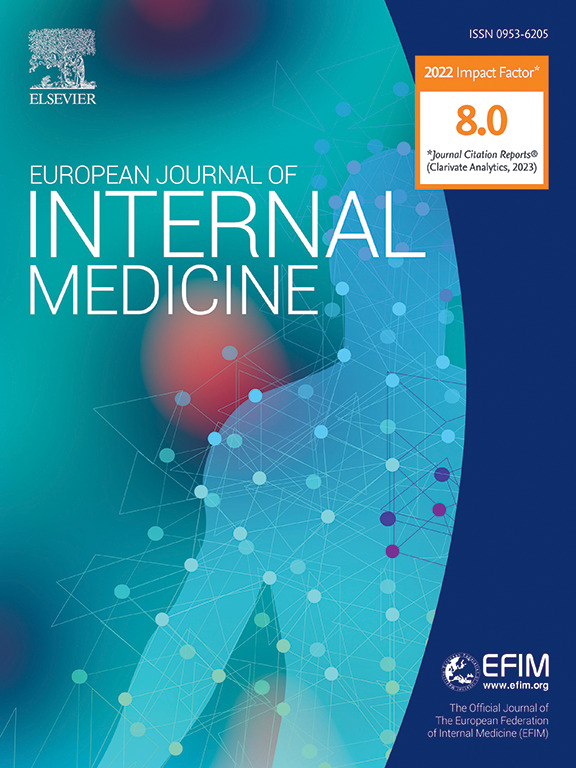A machine learning algorithm for stratification of risk of cardiovascular disease in metabolic dysfunction-associated steatotic liver disease
IF 5.9
2区 医学
Q1 MEDICINE, GENERAL & INTERNAL
引用次数: 0
Abstract
Background
Steatotic liver disease (SLD) is associated with adverse cardiac events. Metabolic dysfunction-associated steatotic liver disease (MASLD) has emerged as a condition characterized by the abnormal accumulation of hepatic lipids that is closely linked to five metabolic disorders: overweight or obesity, impaired glucose regulation, hypertension, hypertriglyceridemia, and low high-density lipoprotein-cholesterol. This retrospective study aimed to stratify the risk of cardiac events in patients with MASLD.
Methods
Patients diagnosed with MASLD through ultrasonography were evaluated. We implemented a machine learning-based approach using a survival classification and regression tree (CART) model to stratify patients based on age, and the number of risk scores was investigated as a predictor of adverse outcomes in the derivation cohort. The primary outcomes were major adverse cardiac events (MACE) including cardiac death, nonfatal myocardial infarction, and revascularization due to coronary artery disease.
Results
Among 2,962 patients (median age, 62 years; men, 53.5 %), the distribution of risk factors was as follows: one (10.8 %), two (28.5 %), three (33.0 %), four (19.9 %), and five (7.8 %). Over a median follow-up period of 6.8 years, 170 (5.7 %) patients experienced MACE. In the derivation cohort of 2,073 patients, the CART model identified age ≥60 years old and risk factors ≥4 as significant predictors of MACE. These findings were corroborated in a validation cohort of 889 patients. Patients meeting both criteria exhibited the highest risk of MACE (log-rank test, p < 0.001).
Conclusions
Patients aged ≥60 years old with risk factors ≥4 indicates at high risk of MACE in patients with MASLD. This risk stratification system provides a practical tool for identifying high-risk individuals in the MASLD population.

用于代谢功能障碍相关脂肪肝心血管疾病风险分层的机器学习算法。
背景:脂肪肝(SLD)与不良心脏事件有关。代谢功能障碍相关性脂肪性肝病(MASLD)是一种以肝脏脂质异常积聚为特征的疾病,与五种代谢紊乱密切相关:超重或肥胖、葡萄糖调节功能受损、高血压、高甘油三酯血症和低高密度脂蛋白胆固醇。这项回顾性研究旨在对MASLD患者发生心脏事件的风险进行分层:方法:对通过超声波检查确诊为MASLD的患者进行评估。我们利用生存分类和回归树(CART)模型实施了一种基于机器学习的方法,根据年龄对患者进行分层,并将风险评分的数量作为衍生队列中不良结局的预测因子进行了研究。主要结果是主要心脏不良事件(MACE),包括心源性死亡、非致死性心肌梗死和因冠状动脉疾病导致的血管再通:在 2962 名患者(中位年龄 62 岁,男性占 53.5%)中,危险因素分布如下:1 个(10.8%)、2 个(28.5%)、3 个(33.0%)、4 个(19.9%)和 5 个(7.8%)。在 6.8 年的中位随访期内,170 例(5.7%)患者发生了 MACE。在由 2,073 名患者组成的衍生队列中,CART 模型确定年龄≥60 岁和风险因素≥4 个是 MACE 的重要预测因素。这些发现在由 889 名患者组成的验证队列中得到了证实。符合这两项标准的患者发生 MACE 的风险最高(对数秩检验,p < 0.001):结论:年龄≥60 岁且危险因素≥4 的患者表明,MASLD 患者发生 MACE 的风险很高。该风险分层系统为识别MASLD人群中的高危个体提供了实用工具。
本文章由计算机程序翻译,如有差异,请以英文原文为准。
求助全文
约1分钟内获得全文
求助全文
来源期刊
CiteScore
9.60
自引率
6.20%
发文量
364
审稿时长
20 days
期刊介绍:
The European Journal of Internal Medicine serves as the official journal of the European Federation of Internal Medicine and is the primary scientific reference for European academic and non-academic internists. It is dedicated to advancing science and practice in internal medicine across Europe. The journal publishes original articles, editorials, reviews, internal medicine flashcards, and other relevant information in the field. Both translational medicine and clinical studies are emphasized. EJIM aspires to be a leading platform for excellent clinical studies, with a focus on enhancing the quality of healthcare in European hospitals.

 求助内容:
求助内容: 应助结果提醒方式:
应助结果提醒方式:


